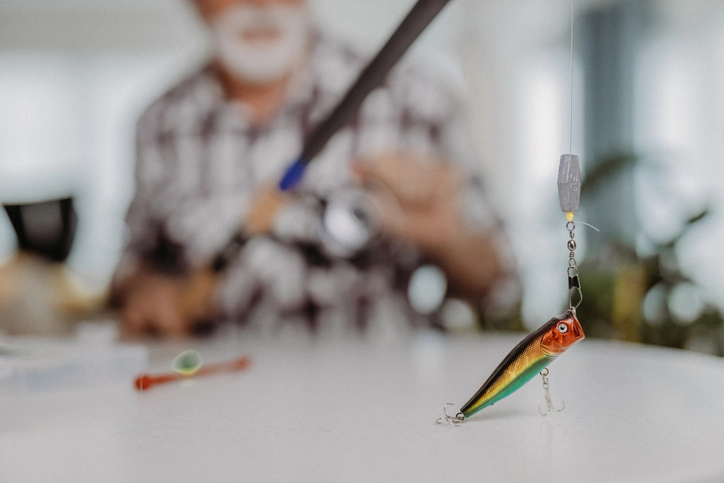How to Choose a Fishing Reel to Match Rod
Are you finding it confusing to understand the meaning of model size numbers? Spinning reels come in various sizes, making it challenging to grasp their significance and determine the most suitable reel size for your fishing needs.
Fear not! Fishing Tackle Shop, a prominent player in the fishing tackle eCommerce industry, is here to assist you. Renowned for furnishing a wealth of information, we aim to empower you to make well-informed decisions when choosing products from our store. Surprisingly, a quick internet search yielded minimal information about fishing reel sizes. Consequently, we took the initiative to create a comprehensive guide that caters to both novice and seasoned anglers. This guide is designed to help you identify the best fishing reels based on sizing that aligns with your specific angling requirements.
So, what’s the deal with reel sizing? Numbers like 1000, 2000, 3000, 20, 25, 30, etc., can be a bit perplexing. To clarify, each manufacturer employs its rating system, so there’s no fixed standard. However, as a general rule, smaller model numbers typically indicate smaller reels, though there’s a bit of variation. You might encounter a spinning reel labeled as a size 20, 2000, 25, or 2500 – but don’t be confused; these are essentially the same size, with the differences arising from how each fishing reel manufacturer brands its products.
Now, how do you select the right reel for your needs? When perusing our selection of fishing reels for sale, consider where you intend to use the reel. What works well in rivers or lakes might not be the optimal choice for saltwater fishing from a boat or the rocks.
In the following guide, we’ve categorized fishing reels into small, medium, and large sizes. Additionally, we’ve included information on recommended line classes, popular types of angling, common fish targets, and even suggested rod pairings.
While this article serves as a guide, focusing on common applications, it’s worth noting that our reels may have various other uses. Nevertheless, we believe this guide will prove immensely helpful in your quest to find the ideal fishing reel.
Should you still require further assistance, feel free to reach out. Contacting us through live chat, email, or phone is all it takes, and we’ll be more than happy to help.
The positioning and elements of a rod play a crucial role in determining its performance. Simply shaking, bending, or “hefting” a rod power in the showroom won’t bring you any closer to finding the ideal one. To guide you in the right direction, here are a few helpful tips.
DECIDE BEFOREHAND WHAT YOU ARE SEEKING
Don’t approach shopping for fishing rods as you would for a tomato. It’s not about aesthetics or a nice feel; it’s about seeking performance. Consider your target catch, pound test line, lure type, line material, and ideal length. Explore rod websites to understand terms like “action,” “power,” and “speed.” This step can streamline your search, eliminating 90% of store options before you leave.
BRING THE REEL WITH YOU WHEN YOU GO TO THE STORE
When you need to match a nut or bolt, you take it to the store with you. Similarly, when tackling plumbing repairs, you carry the PVC fitting in your pocket as you navigate the plumbing aisle. Strangely, we’re more ready to buy a 50-cent PVC fitting than the best fishing rod. Usually, you know the reel for the rod you seek. Bringing it with you during shopping is a crucial step in finding a high-performing rod. Reference your responses from step 1 and narrow down your search to suitable rods. Examine the line weight ratings and lure weight range printed on the rod, and choose the options that align with your requirements.
PRIORITIZE LETTING “FIT” GUIDE YOUR DECISION
Opting for well-known brands ensures you receive value for your money. Your preferred brand has consistently delivered satisfactory performance, earning your trust and loyalty over time. While it’s advisable to seek a rod that complements your trusted reel manufacturer, avoid restricting your choices solely to a particular brand. Don’t settle for a rod that doesn’t align with your reel. Numerous quality rods are accessible across various price ranges, so prioritize performance in your selection process.
ATTACH THE REEL TO THE ROD AND ASSESS ITS PERFORMANCE
Now, let’s dig deep into the details.
Once you’ve identified a spinning rod that meets your criteria, take the spool off your reel and affix the reel onto the rod. Place it on the edge of a counter, aligning the spool axle with the counter’s edge. When properly set up, you’ll observe a point on the rod extending beyond the counter’s edge – termed the “choke” point, crucial in the layout. Guides “on the counter” refer to larger guides that manage and limit line flow during casting (reduction guides).
Conversely, guides “off the counter” direct and channel the line to the rod’s tip (running guides). If the top edge of the reduction guides aligns with the counter’s edge, the rod is well-matched with your reel. Some layouts shift guides from this line, but reduction guides follow the reel’s spool axle angle. A perfect match might be challenging with a production rod, but a closer match improves rod performance with your reel.
If alignments seem off or angles appear awkward, consider trying another rod. It’s possible that a lighter, smaller reel may not “fit” well with a heavier blank. Manufacturers design rods for specific groups of reels to better harmonize with the rod’s action and power. Let the reel be your guide in determining if you’ve selected the right rod.
Concluding Evaluation: Who says you can’t assess the casting performance with your reel?
Reaching this stage, it’s evident you value performance, not just preparing for a $ 30-rod purchase. More likely, you’re gearing up to make a substantial investment of a few hundred dollars. Would it not be logical to reattach the spool to your spinning reel or mount your casting reel and carry out one last test?
STATIC LOADING
Regardless of the rod type, the rod’s POWER is derived from its capacity to transfer the stored energy within the bent rod to the guides and then into the line, exerting pressure on the fish. The efficiency of this process increases when the line closely follows the natural bend of the rod. Evaluate by comparing the “natural” bend (shape lifting weight from the tip) with the bend when lifting weight through all guides. While this is a somewhat intricate test, it’s not necessary to perform it in the showroom. Instead, thread your line through the guides, have the sales representative hold the line, and flex the rod into a “deep” bend.
For spinning rods, ensure there are enough guides to closely track the line along the blank. Any resemblance to a strung bow (like a bow and arrow) is unfavorable. This “bowstring effect” signifies power loss from the rod and should be avoided.
Once you’ve identified the ideal match, it’s advisable to step outside and test cast before reaching for your wallet. Your chosen combination should exhibit qualities such as quiet operation, smoothness, long casting abilities, and high sensitivity.
An aspect overlooked in the Fuji article is the crucial factor of balance. When the reel is attached to the rod, the pivot point should be in proximity to the front of the handle. At this juncture, the rod should rest horizontally when balanced on a fingertip. This positioning ensures that when the angler holds the rod in hand (as is typical during use), the rod pivots around the forefinger, causing the tip to slightly point downwards.
This alignment is perfect for retrieving lures. If you desire the rod tip to be in a horizontal position, using the forefinger as the pivot point, it will be necessary to either increase the reel weight or add extra weight to the butt of the rod.
Hopefully, all of this information makes sense and helps eliminate some of the guesswork when choosing a rod to complement your favorite spinning reel.
What Size of Reel Do I Need?
Selecting a reel is a crucial consideration, and matching the reel size to the power of your spinning rod is vital. The reel sizes, as illustrated below, may be labeled in thousands or two digits, but both representations convey the same information. The sizes progress in ascending order, starting from small to medium, then large, and concluding with very large.
1000 to 3500 (10 to 35): suitable for an ultra-light to light-power rod.
4000 to 5500 (40 to 55): designed for a medium-power rod.
6000 to 9500 (60 to 95): intended for a medium-heavy to heavy-power rod.
10000 and above is ideal for an ultra-heavy power rod.
What Size Line do I pair with my Reel?
Selecting the appropriate line is a crucial decision when spooling a reel. Avoid using a light line on a heavy setup to prevent frequent break-offs. Conversely, a heavy line on a light setup compromises finesse and may exceed spool capacity.
To strike a balance, it’s crucial to find a middle ground. Here are the recommended line weights for various spinning reel sizes:
1000 to 3500 (10 to 35): Opt for 2-10lb mono or 4-14lb braid.
4000 to 5500 (40 to 55): Use 8-14lb mono or 15-50lb braid.
6000 to 9500 (60 to 95): Consider 12-30lb mono or 30-80lb braid.
10000 and above: Utilize 12lb or higher mono, or 50lb or higher braid.
What Type of Reel do I need for a Specific Water & Species?
Small spinning reels prove excellent for targeting smaller freshwater species like smallmouth bass, trout, bream, and panfish. Typically, a small setup performs well in most lakes, ponds, bays, and small rivers. Transitioning to a medium setup enhances your ability to tackle larger species such as largemouth bass, cod, smaller salmon, and walleye. These rods are versatile, allowing for lighter offshore fishing and application in various bodies of water covered by a small setup.
Moving up to large setups equips you to handle a diverse range of bigger fish, from snapper to steelhead. These setups are particularly effective for surf fishing, large lake fishing, rock fishing, and fishing from boats. The large setup proves optimal for tackling substantial saltwater rod targets like marlin, sharks, tuna, and halibut. Primarily designed for offshore boat fishing, these setups can also be employed for some surf fishing scenarios.
What’s the Difference between a Saltwater Reel & Freshwater Reel?
There are two significant distinctions between saltwater reels and freshwater reels. The first distinction revolves around price, with saltwater reels being considerably more expensive, justified by specific factors. The second difference lies in the materials used, as saltwater reels are constructed from corrosion-resistant materials, contributing to the substantial price difference. While it is possible to wash and rinse a freshwater reel when exposed to saltwater, it’s not advisable to do so regularly. For frequent saltwater fishing, investing in a corrosion-resistant saltwater reel ensures long-term durability and is a wise decision.
Conclusion about How to Choose a Fishing Reel
Selecting the right fishing reel to match your rod is a crucial step in enhancing your overall angling experience. By considering factors such as reel size, line weight, and the specific type of fishing you’ll be undertaking, you can optimize the performance of your equipment. Remember to test the compatibility by mounting the reel on the casting rod and conducting test casts to ensure a seamless fit. Whether you’re targeting freshwater or saltwater species, the right reel-and-rod combo can make a significant difference in your success on the water. Keep these considerations in mind, and you’ll be well on your way to finding the perfect pairing for your fishing adventures. Happy fishing!


